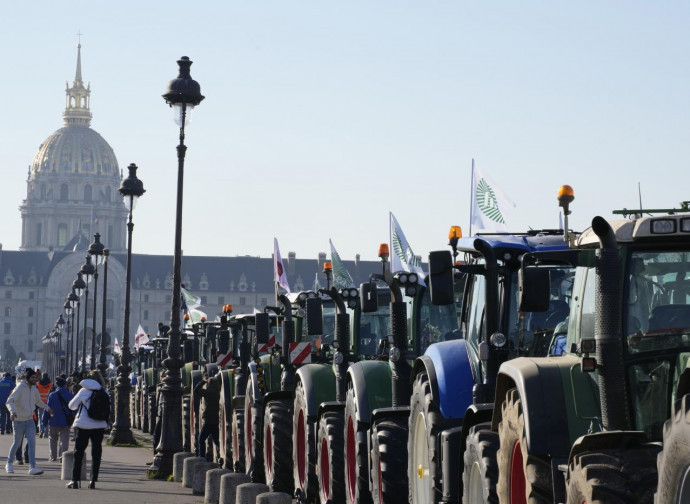EU attack against farmers is self-defeating
The agricultural sector not only ensures food security, but also absorbs four times the carbon dioxide it emits while protecting land. Yet, European institutions are heavily penalising farmers in the name of an illusory climate 'salvation'.

First of a series of two
The agricultural protest that has been winding its way through Europe during the last few months, recently manifested itself also in Italy: here too tractors have taken to the streets to express (fortunately in a composed and civilised manner) a widespread and profound dissatisfaction. Demonstrations of discontent in the countryside began about a year ago in Belgium and Holland. In the country of tulips, even a 'farmers' party' was born, which had a resounding success in the last provincial elections, gaining 19% of the vote, demonstrating a consensus that goes beyond the relatively modest weight of the 'peasant' population. The malaise of the entire European farming world towards EU policies then spread with a 'domino effect'. From France (where the manure scattered by the 'paysans' near the Elysée Palace has become a symbol of farmers' anger at the excesses of bureaucracy, the slowness and harassment of an administration accused of not respecting those who work in the fields), to Germany (where the 'straw that broke the camel's back' was the abolition of the subsidies on agricultural diesel announced by the 'traffic light’ government), passing through Romania, Poland, Hungary, and Greece, the whole of the old continent is criss-crossed by farmers' agitation.
In Italy, too, the fire of protest has been smouldering under the ashes for some time. And now it seems to be igniting, giving vent to sometimes confused motivations, as often happens to those who think that 'everything is going wrong': they complain about market difficulties, production costs, the immobility of trade union representatives actually in an identity crisis, even the damage caused by non-native fauna introduced by probably rash 'environmentalist' initiatives.
The 'citizen' might be tempted to dismiss these expressions of protest as a 'blatant reactionary regurgitation' or as the defence of 'anachronistic corporate privileges' of a sector that in the modern economy appears on superficial examination to have very little weight. As the saying goes, 'when the finger points to the moon, the fool looks at the finger' would be a very serious mistake.
Some keys to interpretation we propose to the reader
Agriculture provides food and commodity security for the planet's 8 billion inhabitants, and according to FAO statistics (https://www.fao.org/faostat - see figure), the percentage of undernourished has fallen from 13.1% in 2002 to less than 8% between 2012 and 2019. Not to be overlooked, however, is the slow climb back up in the percentage of undernourished, with values back above 9% since 2020.
Let us also remember that thanks to photosynthesis, global agriculture absorbs 42 gigatonnes of carbon dioxide every year while emitting only about ten. In essence, it is the only socio-economic sector that is significantly and structurally active in terms of emissions.
Statistics also tell us that at a European level, the food produced by agriculture has never been so healthy: for example, in Italy, according to data from the Ministry of Health (2020 report), food samples with residues of phytosanitary products that do not comply with Italian legislation (notoriously very restrictive and prudential) are only 1.5% among fruit and vegetables and 0.7% among cereals, while no 'outlaw' samples have been found in the oil and wine sectors.
Lastly, the role of agriculture in terms of landscape must not be overlooked: many landscapes that citizens insist on considering natural are actually the result of the millenary action of farmers who maintain them today thanks to their activity. Add to this the fact that agriculture controls the land by protecting it from hydrogeological risk, as demonstrated by the flooding events that have also recently affected hilly areas that in recent decades have been abandoned by agriculture and reoccupied by often degraded forests.
A further element of judgement for those who want to go beyond the commonplace is the fact that agriculture today provides income for around 3 billion human beings (1 billion of whom are engaged in animal husbandry), who work on 590 million farms (9.1 million in the European Union alone). These figures highlight a gigantic structural complexity that should lead us to shy away from interpretations based on slogans or ideological preconceptions: in order to understand the causes of the European agricultural sector's malaise, it would be necessary to go as far as to read the economic and cultivation accounts of individual farms.
Anthony Abbot, patron saint of farmers
After the death of his parents, inspired by the words of Jesus in the Gospel, Anthony sold everything to give it to the poor. He retired to live in the desert and the devil tempted him in vain several times, even in the guise of a pig, from which he later emerged. Young men gathered around the saint and became his disciples, giving an impetus to monasticism. His monks became accustomed to rearing pigs.
Two ways to avoid a global food crisis
The first measure to control global food prices is to put some of the accumulated stocks on the market. But then structural interventions are needed to increase production: the EU has taken the opposite route, focusing on organic farming, therefore developing countries have to go it alone. The negative consequences of Laudato si' and the positive role the Church could play instead.


